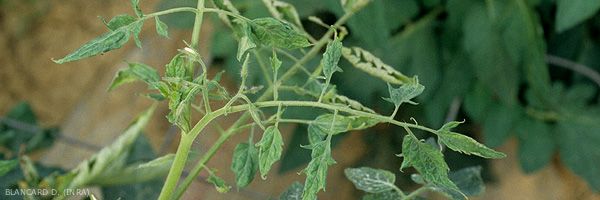
Cucumber mosaic virus
(CMV)
Cucumber mosaic virus
,
- classification : Bromoviridae, Cucumovirus
The cucumber mosaic virus ( Cucumber mosaic virus , CMV) is present in the world , its impact on tomato varies from country to country. It can be serious in temperate production regions, especially in a Mediterranean climate. It is also found in tropical climates, for example in Africa. It is severely rife in Asia, particularly in China, Japan and Taiwan, alone or in combination with other viruses. The same is true in Europe, and more particularly in Italy, Spain and France , where this virus is widely spread in cultures.
In our country, CMV is, together with PVY, one of the most frequent viruses on tomato crops , which it affects quite often in the open field during the summer. It is sometimes found under shelter, in summer, but also at the end of winter, in this case on plants from plants produced at a period of the year during which viruliferous aphids were present in the environment of the nurseries.
Mixed infections with two or even three other viruses are common in the field, especially with PVY, AMV and TSWV, and can lead to exacerbated symptoms.
CMV, a ubiquitous and highly polyphagous virus , was first described on Cucumis sativus in the United States in 1916. It is considered to be the type species of the genus Cucumovirus (Figure 1). It has one of the largest host ranges listed in viruses and very seriously affects field vegetables, in particular cucurbits, but also tomatoes, peppers, spinach, celery, salads? ?.
 |
| Figure 1 |
Several strains of CMV have been differentiated in the past according to their biological characteristics (symptomatology or thermosensitivity), serological criteria and molecular properties. The current official nomenclature mentions 2 groups , I and II, the first group comprising 2 subgroups IA and IB.
Finally, some isolates have a small supernumerary RNA, called "satellite RNA", which can modify the expression of CMV symptoms on some hosts. Thus, in France and Italy, a potentially necrogenic RNA-5 on tomato is sometimes found in weeds collected in nature and in cultivation.





